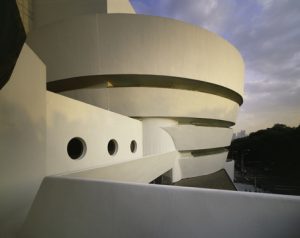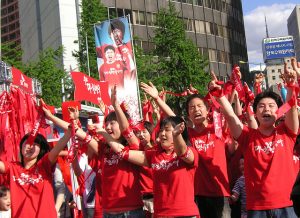Final exams are almost upon us, and many times I wish I could escape the tense atmosphere building up in Lauinger Library and spilling across campus. I wish I had a place to go that would pull my attention away from my essays and chemistry problem sets. Luckily, the Phillips Collection’s Rothko Room provides a space to lose track of time and to-do lists while engaging with four of Mark Rothko’s paintings.
Rothko was an Abstract Expressionist painter who worked in New York City. He gained fame in the 1950s for his large-scale canvases covered with blocks of color, a technique called color field paining. In 1960, the Phillips Collection added a room to house its Rothko works. Rothko himself helped design the exhibition area and advocated for a small room, one painting per wall, and dim lighting.
Upon entering the Rothko Room, four large canvases surround the viewer. The intense orange, yellow, red, maroon, and green blocks draw attention and intensify the feeling that the canvases dominate the space. In Green and Tangerine on Red, Ochre and Red on Red, and Orange and Red on Red, Rothko uses warm colors, which connect the pieces and draws the viewer’s eye between them. Green and Maroon is deep teal, red and blue providing a fresh, cool contrast in response to the heat of the three other works.
Though the paintings look simple at first, sitting down on the bench in the middle of the room and contemplating the pieces reveals subtleties. First, every block of color is polychromatic. The color fields feel vibrant and alive because they contain many hues of the same color. Rothko mixed viscous oil paint with large quantities of turpentine to achieve a new runny consistency. This technique allowed him to paint layers upon layers on his canvases and create the tonal variations of color. On close inspection, the paintings even appear to swim and move before the viewer’s eyes. Rothko’s tonal technique is clear in the large green field of Green and Maroon and subtler in the orange block in Orange and Red on Red.
The design of the room also compliments the subtleties of the paintings. Dim lighting intensifies the vibrancy of the colors and makes the viewer stand close to the work to perceive all the tonal variations. Similarly, the small dimensions of the room focus the viewer’s attention on the canvases. The space creates a bubble in which the viewer is forced to interact with the paintings simply because of proximity with them. In addition, each painting is hung at about the center of the wall, and each is close to the ground. Because the paintings are on the viewer’s level, and they are not elevated to shoulder-height, the paintings demand more attention.
Sitting for ten minutes in the Rothko Room provides the opportunity to notice all of these subtleties and many more. Maybe the color fields look like stain glass or windows into underwater and celestial worlds. Above all, the paintings aim to provoke an emotional response that Rothko likened to reactions people have to music. In his words, “The people who weep before my pictures are having the same religious experience I had when I painted them. And if you, as you say, are moved only by their color relationships, then you miss the point!”
Photo: William Kimber via Flickr





